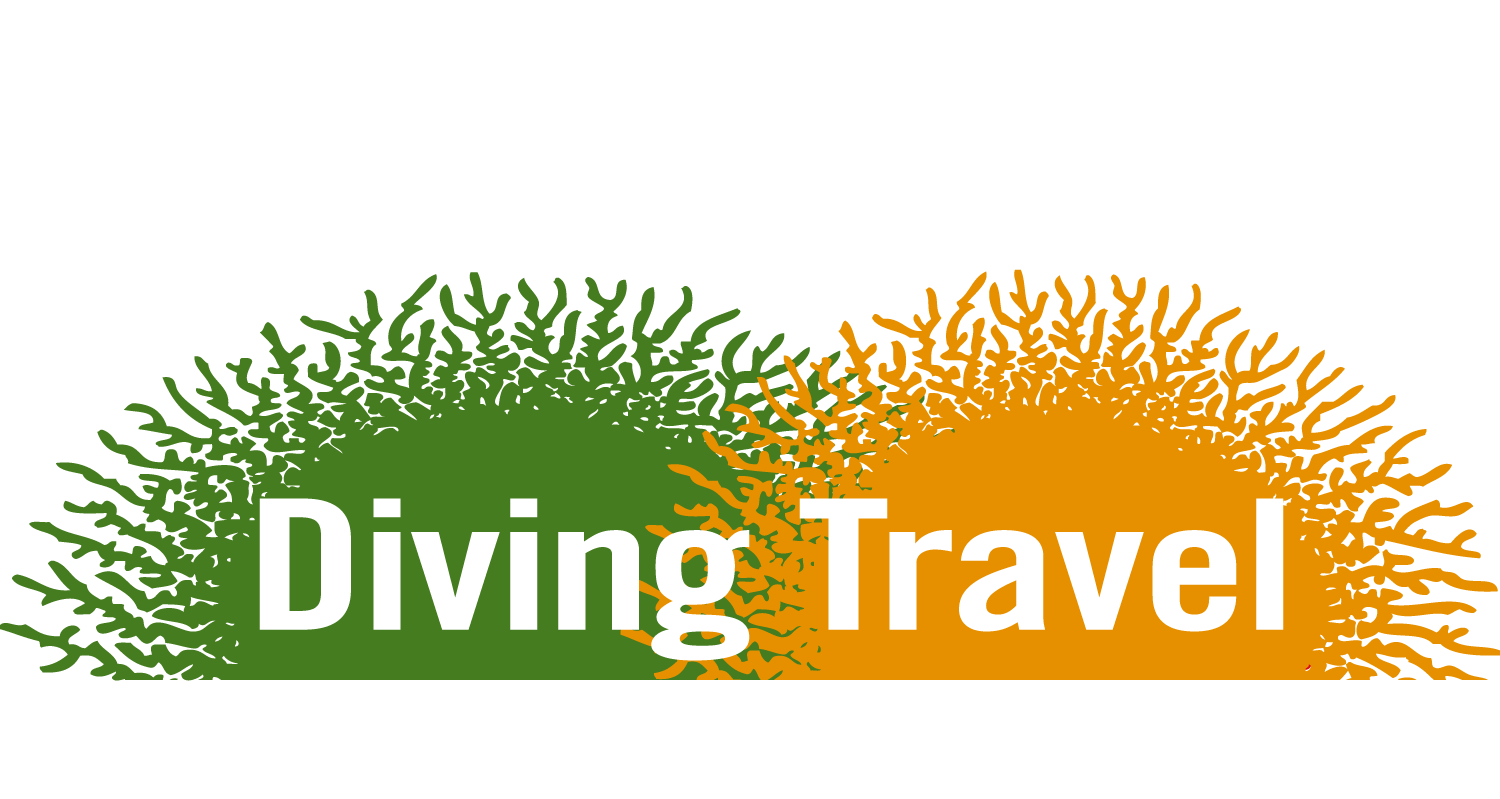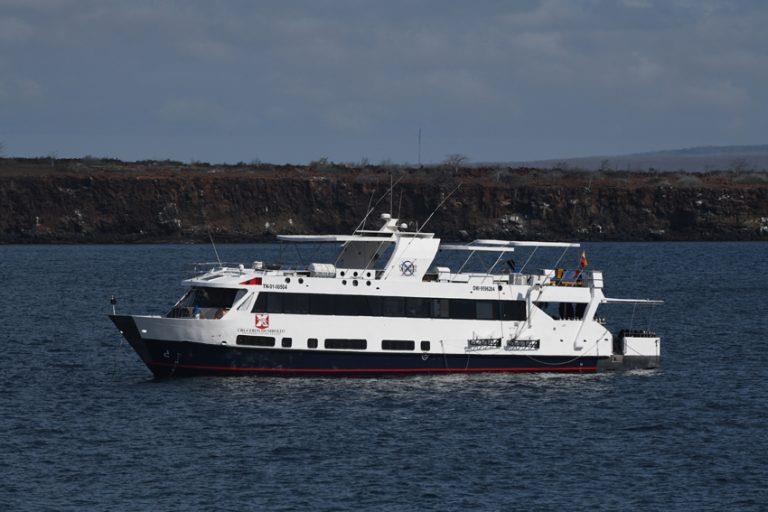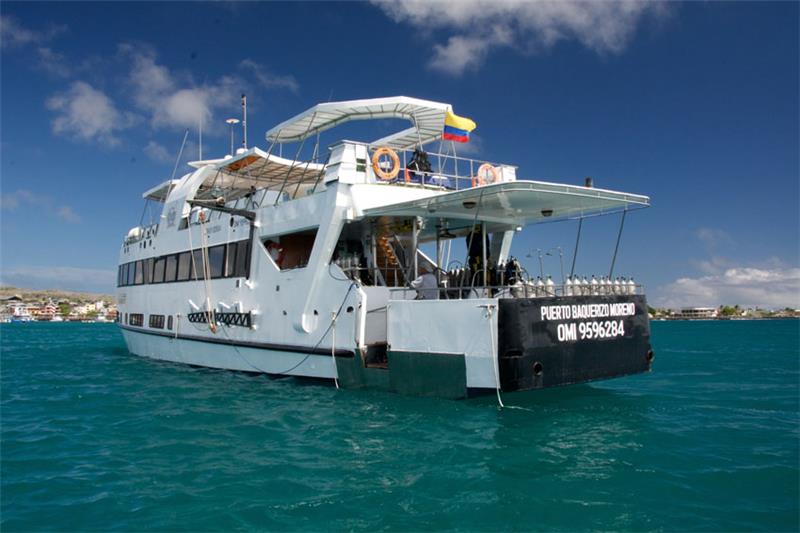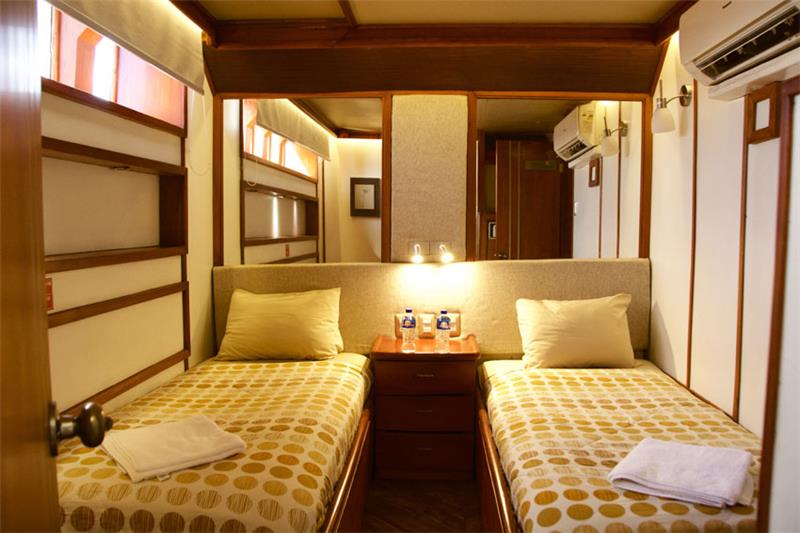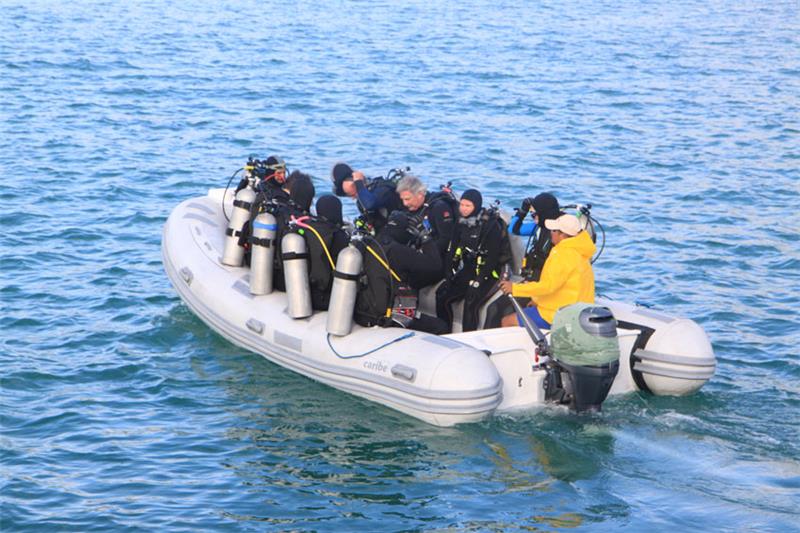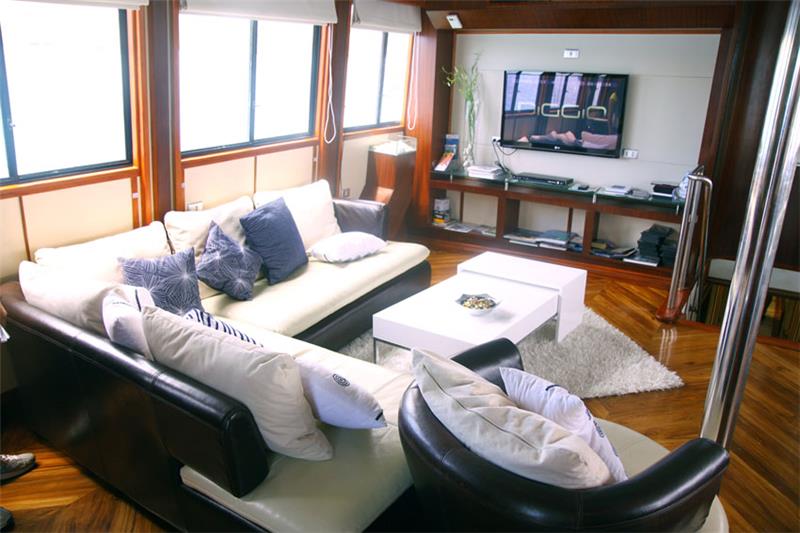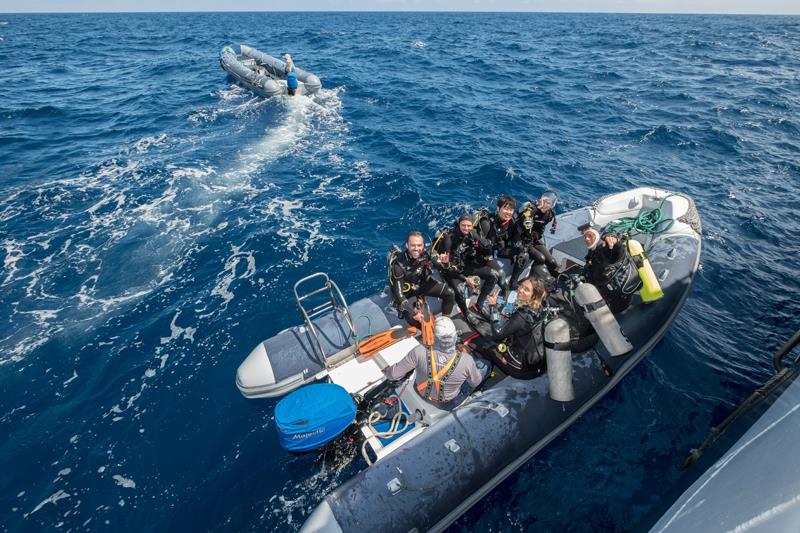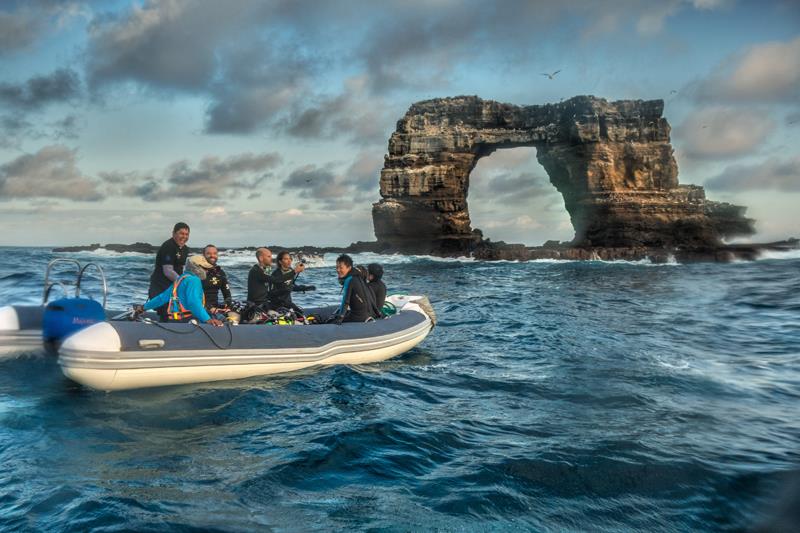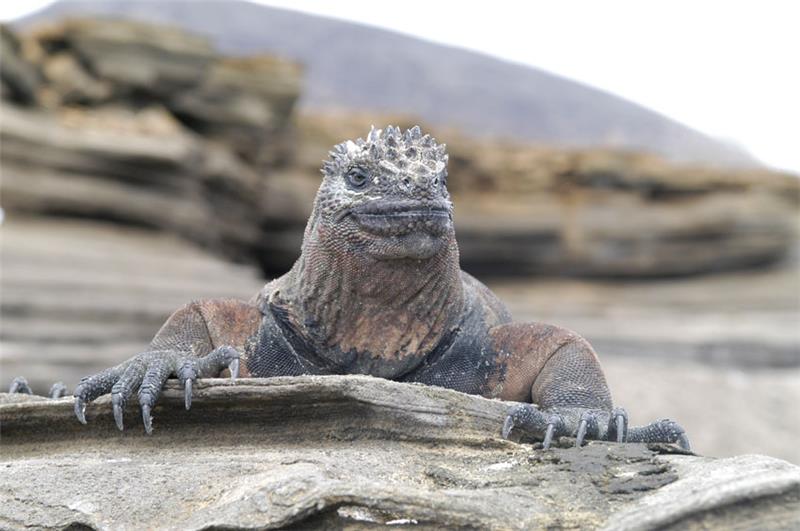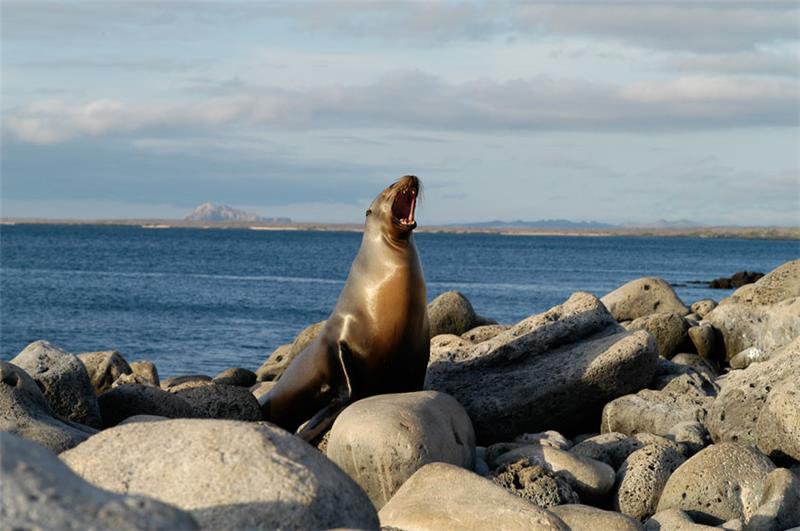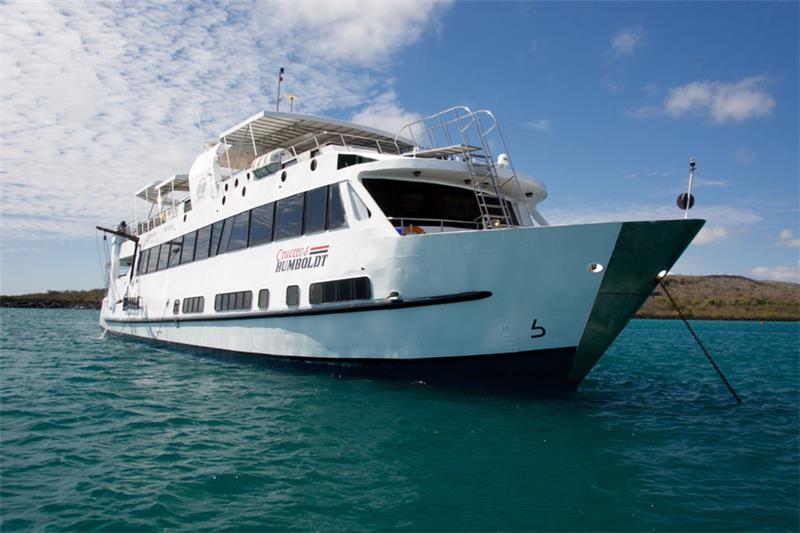Roomtypes
The M/V Humboldt Explorer comfortably accommodates 16 passengers in 8 air-conditioned rooms, all of which have private bathroom facilities. Most rooms have twin beds that convert to larger beds for couples, flat screen televisions and windows to maximize the view of the Pacific Ocean and Galapagos Archipelago. Cabins are on the main and lower decks. The air-conditioned salon on the main deck includes dining tables, TV, VCR, CD/DVD, video library and lounge area. Sunning/viewing areas, ample seating and a hot tub are located on the top level. The dive deck is equipped with individual gear bins, camera table, recharging station, air and nitrox filling stations, tank racks and a separate fresh water rinse tank for underwater camera equipment. Diving operations are conducted from two large pangas (tenders), easily boarded from the dive deck. The Humboldt Explorer is also equipped with a satellite telephone for outgoing calls worldwide.
Packages Include:
- Airport transfers
- 7 nights/8 days aboard vessel
- 3 meals daily, plus between-dive snacks
- 2 - 4 dives daily – total of 18-19 dives
- Use of tanks, weights, and belts
- All domestic alcoholic and non-alcoholic beverages
Packages Do Not Include:
- Flight to /from Ecuador
- Hotel accommodations
- Flights to/from Galapagos
- Last evening dinner
- Rental, instruction, nitrox and retail charges
- Crew gratuities
- Trip cancellation & dive accident insurance
- Premium alcoholic beverages
- National marine park fees
- TCT tourist card
- Hyperbaric chamber fee
- Fuel surcharge
Map
Central Archipelago, Darwin & Wolf
Monday: San Cristobal (1 Check Out Dive at Isla Lobos)Guests fly to the Galapagos Islands from Mainland Ecuador, arriving in the late morning. The dive guides will meet the guests at the airport and escort them to the Galapagos liveaboard, Humboldt Explorer. Guests will board the vessel after 1:00pm, have lunch and listen to the briefings. After the briefings, the Humboldt Explorer will depart for a short crossing to Isla Lobos for a check out dive and safety briefing. After dinner the vessel will depart to the next scheduled destination.
Tuesday: Punta Carrion (2 Dives)
6:30 and 9:30 dives
Sightings include rays and schools of fish.
Afternoon North Seymour land visit. Walk the path around North Seymour Island to see the large colonies of Blue Footed Boobies and Frigate Birds. Sighting of Sea Lions and Marine Iguanas are also common.
Depart for Northern Islands. (16+ hour transit)
Wednesday: Wolf Island (4 Dives)
6:30, 10:30, 2:00 and 4:30 dives. Possible night dive.
Sightings often include hammerheads, whale sharks, eagle rays, sea lions, Galapagos sharks and silky sharks.
Night anchor at Wolf Island.
Thursday: Wolf Island (2 Dives)
6:30 and 9:30 dives
Transit to Darwin Island (2 Dives)
2:00 and 4:30 dives
Sightings often include hammerheads, red-lipped batfish, eagle rays, sea lions, Galapagos sharks and silky sharks.
Friday: Darwin Island (4 Dives)
6:30, 10:30, 2:00 and 4:30 dives
Sightings often include hammerheads, whale sharks (in season) eagle rays, Galapagos sharks and silky sharks.
Transit to Wolf Island
Saturday: Wolf Island (3 Dives)
6:30, 9:00 and 11:00 dives
Sightings often include hammerheads, whale sharks (in season), eagle rays, Galapagos sharks and silky sharks.
Long transit to Cousin’s Rock (20+ hours)
Sunday: Cousin’s Rock (1-2 Dives)
6:30 and 9:30 dives (number of dives dependent on travel time from Wolf Island)
This is a great macro diving with an excellent chance of seeing sea horses, sea lions and eagle rays. Lunch will be served while transiting to Santa Cruz (3 hours). Travel by bus to the Santa Cruz Highlands to visit the giant tortoises in their natural habitat. Visit the town of Puerto Ayora and the Darwin Centre on your own. Dinner on your own in Puerto Ayora. Return to the Humboldt Explorer at 8:30pm.
Monday: San Cristobal
Depart the vessel by 9 am. Guests are free to visit the beach in town to see sea lions and marine iguanas in their natural habitat or take a short walk to the Interpretive Centre. Transfer back to the airport for flight back to Quito or Guayaquil.
Galapagos Liveaboards
The Galapagos Islands are an archipelago of 19 islands located in the Pacific Ocean approximately 1,000 kilometers west of Ecuador's mainland. The trip to Galapagos goes through connecting flights via the mainland of Ecuador. A diving trip to Galapagos offers unforgettable diving experiences and meetings with unique animals such as sea iguana, galapagos sea lions, the galapagos penguin and the galapagos shark. The islands are also known for fantastic shark diving around Wolf and the Darwin Islands. These small and remote islands are best reached by liveaboards. Your diving experiences on Galapagos will probably include Galapagos sharks, silky sharks and lots of schooling hammerheads being cleaned by king angelfish. Seeing marine turtles, schools of tuna, eagle rays, and sea lions is very common and seeing a whale shark is very possible from June through November. All the islands you travel to are amazing sites for underwater photography. Diving in Galapagos is about the big animals, but Galapagos can also offer a huge variety of unique small animals such as seahorses and nudibranches in all fantastic colors.About the country
Galapagos Islands is part of the Republic of Ecuador, Ecuador is a country in northwestern South America, bordered by Colombia on the north, Peru on the east and south, and the Pacific Ocean to the west. The capital city is Quito and the largest city as well.
VISAS
There are two general categories of visas, resident (sometimes knows as immigrant) and non-resident. Within each of these broad categories are several types of specific visas. Please look below for the type of visa that suits your individual needs. This information was adapted from the Ecuadorian Embassy and General Consulate webpages. The information is subject to change and should be verified with the Ecuadorian Consulate in your home country.
Currency
The US dollar is the official currency of Ecuador; therefore, it is not necessary to purchase currency before arriving. Most major credit cards are accepted widely when shopping ashore, however, additional fees are charged in Ecuador for the use of credit cards.
